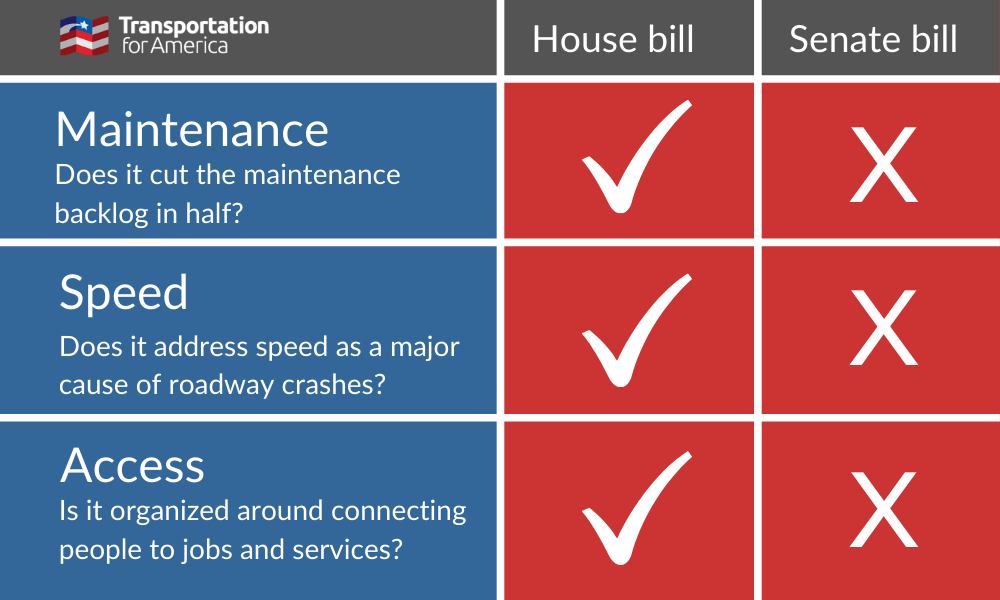
Five things to know about the INVEST Act, and how it compares to Senate bill

With the INVEST Act clearing a crucial vote in committee last week, it moves to the full House for a final vote. We’ve covered the bill from nearly every angle, but here are five important things to remember as the bill moves forward, including how it radically outperforms the Senate’s status quo proposal on reauthorization.
The scale of change in the INVEST Act is a sign that leaders in Congress are taking reforms seriously, but they need to know that you care about this too. Will you send a message to your representative and urge them to support modern transportation policy? Take action here >>
1) What’s next for the INVEST Act?
Late last Thursday, the House Transportation and Infrastructure Committee approved the INVEST Act after two days of considering amendments and marking up the bill. Over the weekend, the House Democrats announced their $1.5 trillion Moving Forward Act for infrastructure and stimulus investments, which incorporates this $500 billion multi-year INVEST Act. (The Moving Forward Act is the legislative version of the broad infrastructure framework they released earlier this year.)
This means that the INVEST Act will be considered as part of that larger bill, rather than with a separate vote like all other reauthorization proposals. Without a proposal for paying for the INVEST Act or the rest of the $1.5 trillion package, House Democrats are using the Moving Forward Act to signal their broad, overarching priorities for stimulus and infrastructure investments. Regardless of the outcome on this whole big package, the INVEST Act represents the starting point for one-half of Congress on reauthorization. And that’s why we are calling on everyone who cares about overhauling the nation’s transportation policy to weigh in with your representative: Make sure your rep knows that the INVEST Act is Congress’ best chance to finally move the needle.
2) The state of repair is strong!
In our initial scorecard, the original bill got neither a ✔ or an ✖ on our core issue of prioritizing repair and maintenance thanks to some significant loopholes. Thankfully, the bill got those needed changes due to the bipartisan leadership of Reps. Garcia (D-IL) and Gallagher (R-WI). They proposed important fixes via an amendment that passed by a voice vote—not a single member of the committee opposed it, giving our INVEST scorecard a solid checkmark for repair.
SENATE: In incredibly stark contrast, the Senate took a look at the country’s backlog of repair needs and the tendency for states to ignore those needs while building and widening new roads, and decided to opt for the status quo, dumping more money into a program that has allowed expansion in place of repair for decades. (The Senate Environment and Public Works Committee passed the America’s Transportation Infrastructure Act last July.) The INVEST Act represents a fundamentally different approach to repair.
3) Safety is front and center
The INVEST Act incorporates a focus on safety throughout all federal programs, overhauling a broken system that allows states to increase pedestrian deaths without penalty, dedicating more funding to protect the most vulnerable, and making changes to how we set speed limits to prioritize safety, and prioritizing access rather than speed. There is still room to improve this area, but we do especially thank Rep. Steve Cohen for introducing the Complete Streets Act of 2019 which sparked many of these changes.
SENATE: The Senate included new safety programs and language encouraging agencies to adopt Complete Streets designs and plans, but those programs would be undercut by failing to include the INVEST Act’s kind of overarching requirements to prioritize safety throughout. The Senate bill considers safety to be an option that agencies can and should pursue, but the last 20 years have proven that making Complete Streets designs or safety “optional” will result in an increase in deaths for people walking or biking.
4) Looking beyond cars to measure how well everyone can get where they need to go
We wrote at length about how the House sets existing policy on its ear by finally starting to organize all spending around improving access for everyone, by all modes:
The INVEST Act creates a new performance measure that requires project sponsors to improve access to jobs and services by all modes. While seemingly minor, this marks a huge shift in how transportation funding would be allocated—especially because project sponsors will be penalized if they fail to use federal funding to improve access. …Under the INVEST Act, states and MPOs must consider whether people traveling (not just driving) can reach jobs, schools, groceries, medical care and other necessities. And they will be penalized if they fail to use federal funding to improve that access.
SENATE: The Senate created a new pilot program to bring this kind of approach to a very small slice of all funding. Based on the COMMUTE Act, it would help a select group of states and metros measure whether or not their investments are connecting people to jobs and services. But as with the safety provisions (as noted above), the benefits would be limited by the fact that the other $358 billion in the Senate’s proposal would be spent using standards that often make access worse for many people with every dollar spent.
5) Bipartisanship is good, but it’s also failed to produce a new vision for transportation
House Republicans complained they were left out of the process on the INVEST Act. Even though the repair amendment was approved with a bipartisan voice vote, all of the House Republicans on the committee voted against the bill in the final committee vote. And as noted above, it’s being incorporated into a larger package which will almost certainly see a party-line, partisan vote for and against.
SENATE: Many on the Senate side have been bragging that their proposal was bipartisan, but that’s more of a reflection of the fact that both Senate Democrats and Republicans lack vision. Infrastructure has always been hailed as the place where Congress comes together, but that’s merely because the debate about policy usually begins and ends with the price tag. In the bipartisan transportation bills of the last decade, there was no (potentially controversial) new vision offered, and bipartisan majorities rallied to pass bills that gave everyone a little more money while undermining each party’s priorities equally and failing to replace a broken system. This is why the loudest cries for “bipartisanship” often come from the most entrenched interests, like state DOTs.
The Senate’s bill doubles down on the status quo and does little to nothing to support innovation, get more value for the dollar, fix existing infrastructure, improve safety, ensure access to economic opportunity for all people, address climate or today’s public health crisis. The INVEST Act is not perfect, but it is a different kind of bill that’s challenging many of these old, ingrained rules.
Wrapping up
A final agreement on reauthorization is unlikely to happen this year before the FAST Act expires this September. The silver lining is that T4America and other advocates out there have time to convince good government, equity, climate, and public health champions in the Senate that their status quo bill undermines all of these important goals. There’s not much to be proud of in the Senate bill, even if it was bipartisan. If you’re looking for more, you can find more of our issue-based analysis with these links below:



